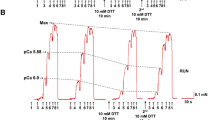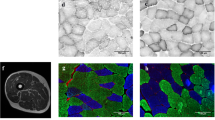Abstract
The alterations in activity patterns of representative enzymes in energy metabolism were investigated in the superficial (white) and deep (red) portions of the fast vastus lateralis muscle of the adult rat in response to prolonged endurance training. It was found that following 15 weeks of extreme training (final running duration: 210 min per day, 27 m/min at 15 degree grade), increases in the activities of marker enzymes of the citric acid cycle (citrate synthase), β-oxidation (3-hydroxyacyl CoA dehydrogenase), and ketone body utilization (3-ketoacid CoA transferase) as well as of glutamate pyruvate transaminase occurred in both regions of the muscle, with the geatest increase being observed in the superficial portion (2.6–4.2-fold). Pronounced increases were also seen for hexokinase which showed highest activities after 7 weeks of training. Conversely, decreases were noted for various glycogenolytic, glycolytic and gluconeogenic enzymes (phosphorylase, glyceraldehydephosphate dehydrogenase, pyruvate kinase, lactate dehydrogenase and fructose-1,6-diphosphatase). Reduction in the activities of these enzymes was most pronounced in the deep portion of the muscle. These results demonstrate a fundamental rearrangement of the energy metabolism of the muscle in response to prolonged, high intensity training. In the case of the deep portion of the vastus lateralis muscle, which has been shown to be composed of a large percentage of fast oxidative-glycolytic fibres (FOG), the enzyme profile becomes similar to the slow oxidative (SO) fibre. In the superficial portion which contains predominantly fast glycolytic fibres (FG), the enzyme profile becomes similar to FOG fibres. The magnitude of the observed changes in enzyme activities was greater than in previous animal studies. This suggests that there might be no limit to the metabolic adaptability of skeletal muscle to increased contractile activity. In this context, the adaptations observed here qualitatively resemble the metabolic transformations reported for chronic low frequency electrical stimulation.
Similar content being viewed by others
References
Andersen P, Henriksson J (1977) Training induced changes in the subgroups of human type II skeletal muscle fibers. Acta Physiol Scand 99:123–125
Armstrong RB, Saubert CW, Sembrowich WL, Shepherd RE, Gollnick PD (1975) Glycogen depletion in rat skeletal muscle fibers during exercise. In: Howald H, Poortmans JR (eds) Metabolic adaptation to prolonged physical exercise. Birkhäuser, Basel, pp 397–401
Baldwin KM, Klinkerfuss GH, Terjung RL, Molé, PA, Holloszy JO (1972) Respiratory capacity of white, red and intermediate muscle: adaptive response to exercise. Am J Physiol 222:373–378
Baldwin KM, Winder WW, Terjung RL, Holloszy JO (1973) Glycolytic enzymes in different types of skeletal muscle: adaptation to exercise. Am J Physiol 225:962–966
Baldwin KM, Campbell PJ, Cooke DA (1977) Glycogen, lactate and alanine changes in muscle fibre types during graded exercise. J Appl Physiol Respirat Environ Exercise Physiol 43:288–291
Barnard RJ, Peter JB (1969) Effect of training and exhaustion on hexokinase activity of skeletal muscle. J Appl Physiol 27:691–695
Bass A, Brdiczka D, Eyer P, Hofer S, Pette D (1969) Metabolic differentiation of distinct muscle types at the level of enzymatic organization. Eur J Biochem 10:198–206
Davies KJA, Packer L, Brooks GA (1981) Biochemical adaptation of mitochondria, muscle, and whole-animal respiration to endurance training. Arch Biochem Biophys 209:539–554
Dudley GA, Abraham WM, Terjung RL (1982) Influence of exercise intensity and duration on biochemical adaptations in skeletal muscle. J Appl Physiol Respirat Environ Exercise Physiol 53:844–850
Eisenberg BR, Salmons S (1981) The reorganization of subcellular structure in muscle undergoing fast-to-slow type transformation. Cell Tissue Res 220:449–471
Fitts RH, Booth FW, Winder WW, Holloszy JO (1975) Skeletal muscle respiratory capacity, endurance and glycogen utilization. Am J Physiol 228:1029–1033
Gleeson TT, Baldwin K (1981) Cardiovascular response to treadmill exercise in untrained rats. J Appl Physiol Respirat Environ Exercise Physiol 50:1206–1211
Green HJ, Thomson JA, Daub WD, Houston ME Ranney DA (1979) Fiber composition, fiber size and enzyme activities in vastus lateralis of elite athletes involved in high intensity exercise. Eur J Appl Physiol 41:109–117
Harris B, Heilig A, Hudlická O, Leberer E, Pette D, Tyler K (1982) Changes in rabbit muscle enzyme activities in response to chronic stimulation with different frequency patterns. In: Semigonovský B, Tuček S (eds) Metabolic and functional changes during exercise. Charles University, Prague, pp 27–31
Heilig A, Pette D (1980) Changes induced in the enzyme activity pattern by electrical stimulation of fast twitch muscle. In: Pette D (ed) Plasticity of muscle. Walter de Gruyter, Berlin New York, pp 409–420
Heilmann C, Pette D (1979) Molecular transformations in sarcoplasmic reticulum of fast twitch muscle by electrostimulation. Eur J Biochem 93:437–446
Heilmann C, Müller W, Pette D (1981) Correlation between ultrastructural and functional changes in sarcoplasmic reticulum during chronic stimulation of fast muscle. J Membr Biol 59:143–149
Hickson RC, Heusner WW, van Huss WD (1975) Skeletal muscle enzyme alterations after sprint and endurance training. J Appl Physiol 40:868–872
Holloszy JO (1967) Biochemical adaptations in muscle—effects of exercise on mitochondrial oxygen uptake and respiratory enzyme activity in skeletal muscle. J Biol Chem 242:2278–2282
Holloszy JO, Booth FW (1976) Biochemical adaptations to endurance exercise in muscle. Ann Rev Physiol 38:273–291
Hudlická O, Tyler KR, Aitman T (1980) The effect of long-term electrical stimulation on fuel uptake and performance in fast skeletal muscles. in: Pette D (ed) Plastcity of muscle. Walter de Gruyter, Berlin New York, pp 401–408
Hudlická O, Tyler KR, Srihari T, Heilig A, Pette D (1982) The effect of different patterns of long-term stimulation on contractile properties and myosin light chains in rabbit fast muscles. Pflügers Arch 393: 164–170
Jansson E, Sjödin B, Thorstensson A, Hultén B, Frith K (1978) Changes in muscle fibre type distribution in man after physical exercise. A sign of fibre type transformation? Acta Physiol Scand 104:235–237
Molé PA, Oscai LB, Holloszy JO (1971) Adaptation of muscle to exercise. Increase in levels of palmityl CoA synthetase, and palmityl CoA dehydrogenase, and in the capacity to oxidize fatty acids. J Clin Invest 50:2323–2330
Molé PA, Baldwin KM, Terjung RL, Holloszy JO (1973) Enzymatic pathways of pyruvate metabolism in skeletal muscle: adaptations to exercise. Am J Physiol 224:50–54
Newsholme EA (1979) The control of fuel utilization by muscle during exercise and starvation. Diabetes 28 Suppl 1:1–7
Newsholme EA, Crabtree B, Zammit VA (1980) Use of enzyme activities as indices of maximum rates of fuel utilization. In: Trends in enzyme histochemistry and cytochemistry. Ciba Foundation Symposium 73 (new series). Exercpta Medica, Amsterdam Oxford New York, pp 245–258
Peter JB, Jeffress RN, Lamb DR (1968) Exercise: Effects on hexokinase activity in red and white skeletal muscle. Science 160:200–201
Pette D, Bücher T (1963) Proportionskonstante Gruppen in Beziehung zur Differenzierung der Enzymaktivitätsmuster von Skelett-Muskeln des Kaninchens. Hoppe-Seyler's Z Physiol Chem 331: 180–195
Pette D, Hofer HW (1980) The constant proportion enzyme group concept in the selection of reference enzymes in metabolism. In: Trends in enzyme histochemistry and cytochemistry. Ciba Foundation Symposium 73 (new series). Excerpta Medica, Amsterdam Oxford New York, pp 231–244
Pette D, Reichmann H (1982) A method for the quantitative extraction of enzymes and metabolites from tissue samples in the milligram range. J Histochem Cytochem 30:401–402
Pette D, Schnez U (1977) Coexistence of fast and slow type myosin light chains in single muscle fibres during transformation as induced by long term stimulation. FEBS Lett 83:128–130
Pette D, Tyler KR (1983) Response of succinate dehydrogenase activity in fibres of rabbit tibialis anterior muscle to chronic nerve stimulation. J Physiol (Lond) 338:1–9
Pette D, Smith ME, Staudte HW, Vrbová G (1973) Effects of long-term electrical stimulation on some contractile and metabolic characteristics of fast rabbit muscles. Pflügers Arch 338:257–272
Pette D, Ramirez BU, Müller W, Simon R, Exner GU, Hildebrand R (1975) Influence of intermittent long-term stimulation on contractile, histochemical and metabolic properties of fibre populations in fast and slow rabbit muscles. Pflügers Arch 361:1–7
Pette D, Müller W, Leisner E, Vrbová G (1976) Time dependent effects on contractile properties, fibre population, myosin light chains and enzymes of energy metabolism in intermittently and continously stimulated fast twitch muscles of the rabbit. Pflügers Arch 364:103–112
Ramirez BU, Pette D (1974) Effects of long-term electrical stimulation on sarcoplasmic reticulum of fast rabbit muscle. FEBS Lett 49:188–190
Reichmann H, Srihari T, Pette D (1983) Ipsi- and contralateral fibre transformations by cross-reinnervation — a principle of symmetry. Pflügers Arch 397:202–208
Salmons S (1980) The response of skeletal muscle to different patterns of use — Some new developments and concepts. In: Pette D (ed) Plasticity of muscle. Walter de Gruyter, Berlin New York, pp 387–399
Salmons S, Henriksson J (1981) The adaptive response of skeletal muscle to increased use. Muscle Nerve 4:94–105
Sarzala MG, Szymańska G, Wiehrer W, Pette D (1982) Effects of chronic stimulation at low frequency on the lipid phase of sarcoplasmic reticulum in rabbit fast-twitch muscle. Eur J Biochem 123:241–245
Schantz P, Billeter R, Henriksson J, Jansson E (1982) Training-induced increase in myofibrillar ATPase intermediate fibers in human skeletal muscle. Muscle Nerve 5:628–636
Seedorf K, Seedorf U, Pette D (1983) coordinate expression of alkali and DTNB myosin light chains during transformation of rabbit fast muscle by chronic stimulation. FEBS Lett 158:321–324
Sréter FA, Gergely J, Salmons S, Romanul FCA (1973) Synthesis by fast muscle of myosin characteristic of slow muscle in response to long term stimulation. Nature New Biol (Lond) 241:17–19
Sréter FA, Pinter K, Jolesz F, Mabuchi K (1982) Fast to slow transformation of fast muscles in response to long-term phasic stimulation. Exptl Neurol 75:95–102
Staudte HW, Pette D (1972) Correlations between enzymes of energy-supplying metabolism as a basic pattern of organization in muscle. Comp Biochem Physiol 41B:533–540
Staudte HW, Exner GU, Pette D (1973) Effects of short-term, high intensity (sprint) training on some contractile and metabolic characteristics of fast and slow muscles of the rat. Pflügers Arch 344:159–168
Terjung RL (1976) Muscle fiber involvement during training of different intensities and durations. Am J Physiol 230:946–950
Terjung RL, Baldwin KM, Winder WW, Holloszy JO (1974) Glycogen repletion in different types of muscle and in liver after exhausting exercise. Am J Physiol 226:1387–1391
Thomson JA, Green HJ, Houston ME (1979) Muscle glycogen depletion patterns in fast twitch fibre subgroups of man during submaximal and supramaximal exercise. Pflügers Arch 379:105–108
Winder WW, Baldwin KM, Holloszy JO (1974) Enzymes involved in ketone utilization in different types of muscle: adaptation to exercise. Eur J Biochem 47:461–467
Author information
Authors and Affiliations
Additional information
Supported by The Deutsche Forschungsgemeinschaft, Sonderforschungsbereich 138, “Biologische Grenzflächen und Spezifität”, and The Medical Research Council of Canada. H. R. is grateful to the Fritz Thyssen Stiftung for a postdoctoral stipend.
Rights and permissions
About this article
Cite this article
Green, H.J., Reichmann, H. & Pette, D. Fibre type specific transformations in the enzyme activity pattern of rat vastus lateralis muscle by prolonged endurance training. Pflugers Arch. 399, 216–222 (1983). https://doi.org/10.1007/BF00656718
Received:
Accepted:
Issue Date:
DOI: https://doi.org/10.1007/BF00656718




